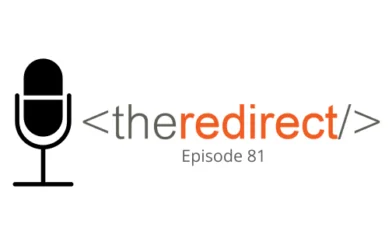Episode 49 / June 15, 2018
Listen now:
Welcome to The Redirect Podcast, where the BlackTruck team shares recent insights and takeaways from the world of search marketing.
In this week’s episode:
- For those tackling PPC ads in AdWords, consider automated rules as a way to better manage your campaigns improve results by building in specific actions (begins at 2:21).
- An in-depth understanding of how content impacts your UX, which can ultimately impact your brand and SEO results (begins at 14:22).
- We share insights from SearchLove Boston 2018 and highlight some of the most talked-about trends in the search marketing industry, and why signals show you should be paying attention to structured data (begins at 24:50).
Automated Rules in AdWords
This lesson came about when I (Patrick) inadvertently over-promised a PPC campaign concept and had to find a solution that seemingly “didn’t exist.” While searching for an answer, I repeatedly found answers that said “not possible,” including in the Google-specific AdWords help forums. Digging deeper into those forums, I eventually found the answer.
In a question asking if there is a way to schedule start/stop dates at the adgroup level (not campaigns), I found a thread with several “no” answers, where a best answer was selected and the thread was disregarded. A few years later, a person chimed in and said, “You can totally do this with automated rules,” which I had never heard of.
The new AdWords interface has many options for automated rules, including campaign rules, ad group rules, keyword rules, topic rules, placement rules—even age range, gender, parental status, and income range rules.
Rules can also be set to automatically “take action” or to “send alert,” where you can manually review if the particular circumstance is worth the action.
Interested in using this method? We take a deeper dive on our blog, with a walk through how it’s done: Automated Rules in AdWords
Content, User Experience, and Brand
We’ve written about human centered SEO before, and often preach the importance—rather, the necessity—of human-centered content. Lately, I (Ashley) have been working on a “blogging best practices guide” to share with our clients that touches on some on-page SEO best practices for blogging, but also includes some basic tips on creating content that matters. Content that matters for your site, yes, but most importantly, content that matters for your audience.
As we know, SEO has evolved over time to be more than using the right keywords, or being associated with the right keywords through links. Of course that’s still part of it, but it’s not necessarily a game of “whomever uses the most keywords wins,” or “whomever accumulates the most links wins.” (For a short audio history of how Google works and has changed over time, check out a recent episode of Seth Godin’s podcast, Akimbo.)
We often discuss with our clients the role of SEO in brand (another podcast shout-out to the MozPod on The Role of SEO in Branding. The Akimbo episode touches on this concept, as well).
I recently stumbled upon an article from UX Matters called “The Role of Content in User Experience.” It’s a great read, and hits a few important points to consider for content that can also contribute to your SEO and brand perception.
I would say the #1 rule to remember when creating content for your website is to create something you yourself would find value in consuming, if you were in your audience. This doesn’t have to be based on a hunch. You can run surveys, polls, interviews, and other research surrounding your existing or desired audience to get a better idea of what would work. If your audience wouldn’t be interested in it, don’t publish it. Pretty easy. But beyond that, it’s important to consider the areas referenced in the UX Matters article:
First impressions
-
- Personalization. It can be as easy as regional personalization; for example, talk like the locals do. Pay attention to dialect and phrasing that will make the visitor feel like you’re speaking their language. It bridges a connection and makes them more inclined to keep engaging with you.
- We’d like to add a note, somewhat related to personalization, and that is to not only speak your visitors’ language in a very literal sense, but to also speak their language when it comes to how you discuss your brand and your services. You may have a way of talking internally that doesn’t necessarily translate to what your audience is looking for, both when it comes to industry-specific terminology and potential keywords.
- Avoid marketing speak that may be a negative trigger or spam signal. Usually, this is phrasing that is too extreme, such as “#1 SEO company” or “Do it today” or “Congratulations, you won a prize just by landing on our site” or “Free offer.” Think about what your audience really wants to hear. It will be different depending on what you offer.
Staying Power and Getting People to Return
Great content is what will keep your audience engaged. If what you produce and share is low-quality, or otherwise doesn’t meet consumers’ expectations, they will not want to keep interacting with you.
So, having quality content can not only impact how you interact with one particular person in your audience, but can also become part of your brand reputation. This loops it all back to SEO as brand. SEO will bring people to your site. Providing good content will keep them on your site. Hence, SEO can become an integral part of your brand (though there’s much more to it than just that).
Jason’s SearchLove Boston Recap
Having just returned from SearchLove Boston (last week), my head is still reeling with a lot of the great information. Excellent speakers this year in Boston, and the venue was great. Hats off Distilled. If you’re not familiar with SearchLove, it’s a series of events put on by the team at Distilled (a London-based SEO firm). It’s a really a great event for in-the-weeds SEO knowledge sharing.
Looking over all my notes, the highlights and areas that I continue to see come up are much in line with not only trends we’ve seen for 2018 and beyond, but really make logical sense from a search marketing perspective and the direction Google is headed.
Will Critchlow, in his “From the Horse’s Mouth: What We Can Learn from Google” talk, spoke on keeping an eye on and reading the output from Google, but to also keep it in check when you’re doing your own testing. In other words… what they say, isn’t ALWAYS the reality, either, so you still need to have some chops in the space. In other other words: Listen to what Google is saying, but proceed with caution.
One other standout from SearchLove is that structured data should be at the forefront of your discussions and checklists when developing a new site.
Thanks for tuning in! To catch future episodes of The Redirect Podcast, subscribe on SoundCloud, iTunes, or Stitcher.




